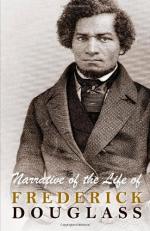
|
| Name: _________________________ | Period: ___________________ |
This test consists of 15 multiple choice questions and 5 short answer questions.
Multiple Choice Questions
1. In what city in Massachusetts did Garrison hear the speech about slavery that is described in the Preface?
(a) Springfield.
(b) Nantucket.
(c) Plymouth.
(d) Boston.
2. What body of water does Phillips say Douglass has seen the ships sailing on in the second Preface?
(a) The Boston Harbor.
(b) The Chesapeake Bay.
(c) Cape Cod.
(d) The Atlantic Ocean.
3. What does Douglass focus on describing in Chapter 3?
(a) The punishments slaves endure.
(b) His teenage years.
(c) The luxuries of slaveholders .
(d) Slave families attempt at staying together.
4. When did William Lloyd Garrison see the abolitionist speech described in the Preface?
(a) 1835.
(b) 1859.
(c) 1862.
(d) 1841.
5. What was the name of the overseer who Douglass describes as cursing all day and whose death was seen as a blessing in Chapter 2?
(a) Mr. Anthony.
(b) Mr. Lloyd.
(c) Mr. Hopkins.
(d) Mr. Severe.
6. When Mr. Lanman bragged about the two killings what happened?
(a) He had to pay a fine.
(b) Nothing.
(c) He had to set two slaves free.
(d) He went to jail for one night.
7. What does Douglass compare the way slaves are treated to?
(a) Children.
(b) Mules.
(c) Uneducated people.
(d) Animals.
8. What did the Colonel often do when the slaves disrespected him?
(a) He reduced their water supply.
(b) He traded them away.
(c) He killed them.
(d) He withheld food.
9. How many overseers were there for the farms that Colonel Edward Lloyd owns?
(a) There were two overseers for the farms.
(b) There was one overseer for every three farms and one main overseer for all.
(c) There was one overseer for each farm and one main overseer for all.
(d) There was only one overseer .
10. What is William Lloyd Garrison well-known for being?
(a) A slave master.
(b) A Civil War soldier.
(c) A slave.
(d) An abolitionist.
11. How many farms did Colonel Edward Lloyd own?
(a) 5.
(b) More than 10.
(c) More than 30.
(d) More than 20.
12. What was a teenage girl in Douglass's own family killed for?
(a) Falling asleep while babysitting.
(b) Talking to the masters children.
(c) Not properly cleaning the kitchen.
(d) Feeding the house animals too much.
13. In what state was Frederick Douglass born?
(a) Massachusetts.
(b) Michigan.
(c) Maine.
(d) Maryland.
14. What is the name of the main farm house that Colonel Edward Lloyd owned?
(a) Great House Farm.
(b) Farm House of Lloyd.
(c) Lloyd Farm House.
(d) Lloyd Family Farm.
15. Garrison asks the reader for sympathy for whom in the Preface?
(a) Himself.
(b) The slaveholders.
(c) The down-trodden victims.
(d) Frederick Douglass.
Short Answer Questions
1. What is the possible real reason that the female slave was beaten?
2. Who was Frederick Douglass's first master?
3. At what age was Frederick Douglass when he was taken from his mother's care?
4. Who did Phillips watch being dragged off to be lynched, according to his narrative in the second Preface?
5. What is the final line of Garrison's Preface (x)?
|
This section contains 506 words (approx. 2 pages at 300 words per page) |

|




